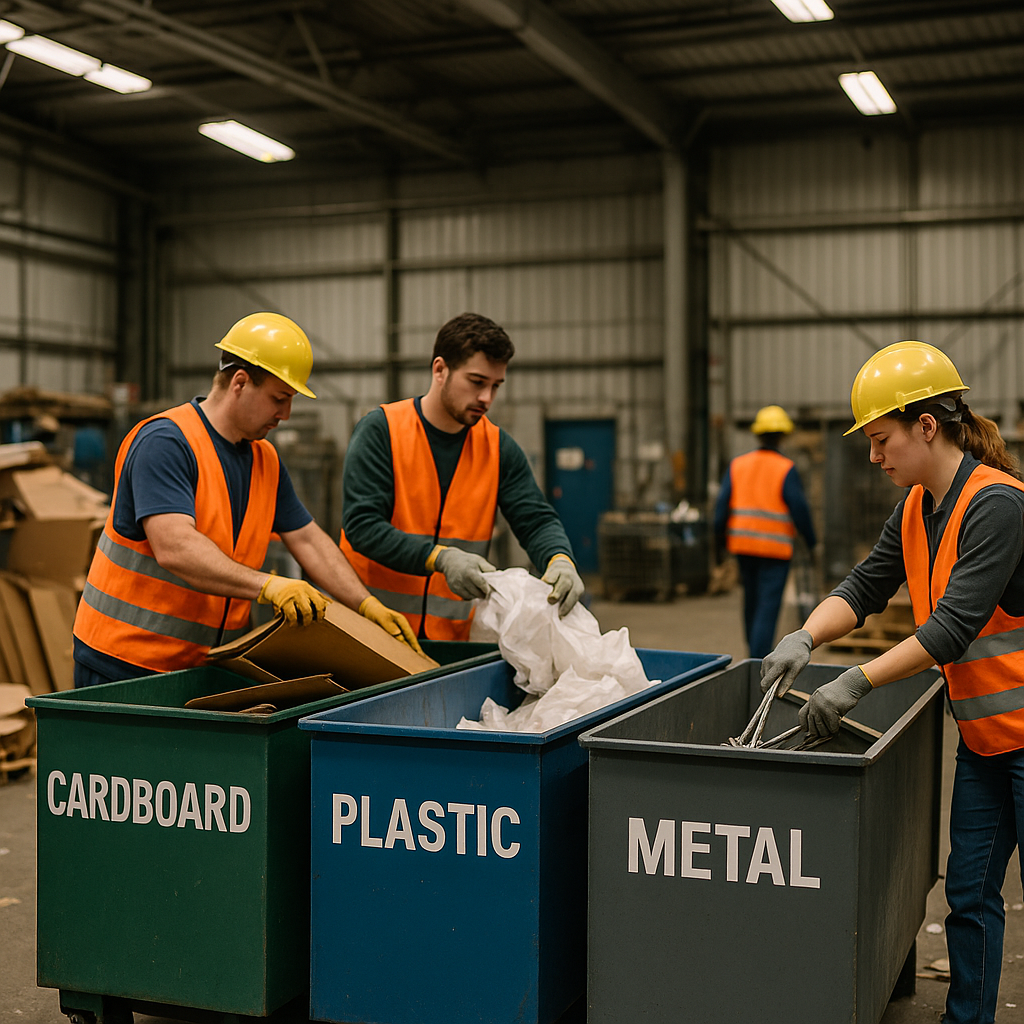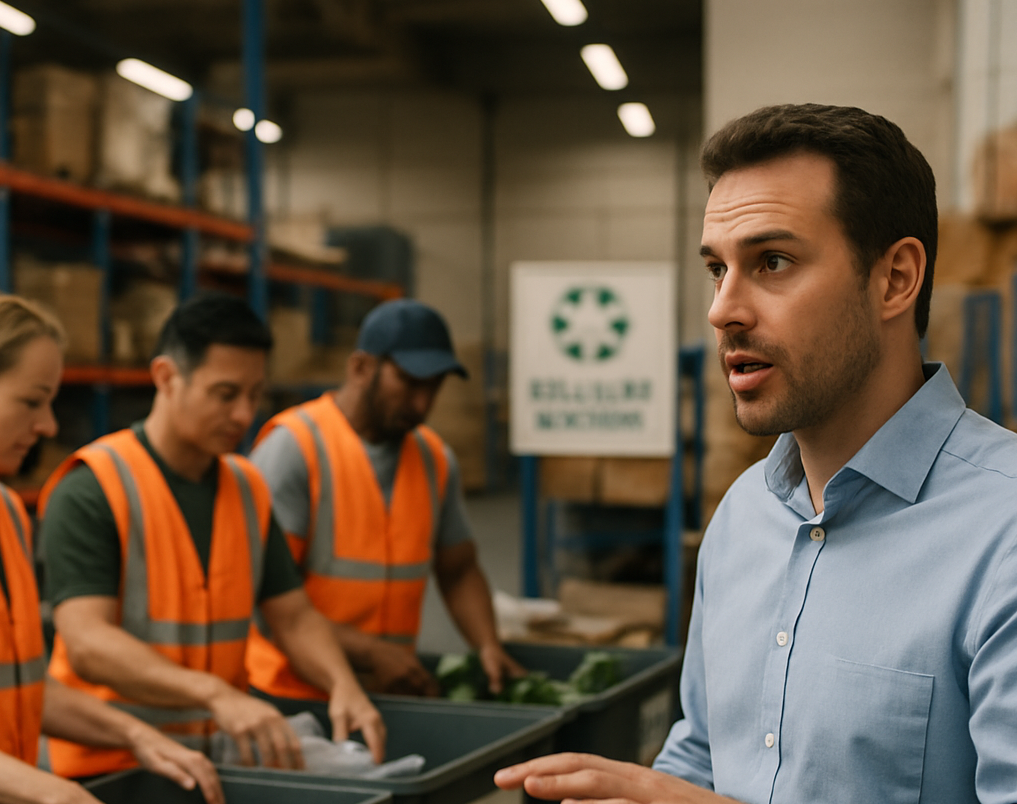5901 Botham Jean Blvd, Dallas, TX 75215
Warehouse Recycling Solutions: Reducing Waste, Cutting Costs, and Streamlining Operations
July 6, 2025With an increasing emphasis on environmental awareness in business, proper waste management has become a critical priority for warehouses across industries. The substantial volume of packaging materials, pallets, and other disposable items flowing through these facilities presents both challenges and opportunities.
Warehouse recycling solutions are strategic initiatives designed to collect, process, and reuse materials that would otherwise be discarded. These comprehensive programs transform how facilities handle everything from cardboard and plastic to metals and electronic components. They establish systematic approaches to waste diversion that align with broader sustainability goals.
These solutions offer benefits extending beyond environmental protection. Effective recycling programs significantly reduce waste disposal costs and may generate revenue from recyclable commodities. They also help operations maintain compliance with increasingly stringent environmental regulations, mitigating potential penalties while boosting brand reputation with eco-conscious clients and customers.
What are the Top Recycling Solutions for Modern Warehouses?

Modern warehouses produce significant waste, which can be redirected from landfills with effective recycling solutions. Implementing efficient recycling systems not only benefits the environment but also enhances operational efficiency and can reduce waste management costs. Here are some of the most effective recycling solutions for today’s warehouse operations.
Single-Stream Recycling
Single-stream recycling has transformed how warehouses manage recyclable materials. This approach allows all recyclables to be collected in one container without necessitating employees to separate materials by type. Its simplicity makes it highly effective in busy warehouse settings.
The benefits are noteworthy. Workers save time by not having to separate materials, leading to higher participation rates. A single collection point reduces confusion and streamlines the recycling process. This system is particularly valuable in high-volume operations where efficiency is essential.
Implementation requires clearly labeled bins placed strategically throughout the warehouse. Employee education is crucial to ensure that only appropriate materials enter the recycling stream. While contamination can be a concern, proper training and signage can mitigate this issue.
Compactors and Balers
Warehouses typically generate large volumes of cardboard, plastic film, and other bulky packaging materials. Compactors and balers compress these materials into dense, manageable bundles. This compression can reduce the physical footprint of recyclables by up to 90% in some cases.
The space savings alone make these machines invaluable for warehouse operations. Compacted materials require fewer pickups, reducing transportation costs and carbon emissions. Additionally, baled recyclables often command better market prices, potentially generating revenue from what would otherwise be waste.
When selecting compactors or balers, warehouses should consider their waste volume, available space, and material types. Vertical balers work well for moderate cardboard volumes, while horizontal balers suit operations with higher throughput needs. Some facilities benefit from specialized equipment for specific materials such as plastic film or styrofoam.
| Criteria | Baler | Compactor |
|---|---|---|
| Primary Use | Recycling | Trash reduction |
| Output | Baled recyclables | Compacted waste |
| Ideal For | Cardboard, plastic, paper, metal | Wet waste, mixed trash |
| ROI Potential | High (via recyclable resale) | Moderate (cost savings on hauling) |
| Common Environments | Warehouses, retail, recycling centers | Restaurants, hospitals, offices |
Customized Collection Services
Every warehouse has unique waste streams based on its operations, inventory, and processes. Customized collection services address these specific needs rather than applying a one-size-fits-all approach. These tailored programs align with warehouse schedules and workflows to minimize operational disruptions.
Professional recycling partners can design collection systems that account for peak periods, seasonal variations, and specific material types. This might include scheduled pickups for certain materials, on-demand collection for others, and specialized handling for unique recyclables.
The personalized approach ensures that materials are collected efficiently and processed appropriately. It also provides flexibility to adapt as warehouse needs change. Many recycling service providers offer ongoing support and adjustments to maintain program effectiveness.
On-Site Waste Audits
On-site waste audits provide warehouses with data-driven insights about their waste streams. Professional auditors analyze the types and volumes of materials being discarded, identify recyclable items currently directed to landfills, and recommend process improvements.
These audits reveal opportunities for both environmental and financial gains, helping warehouses develop targeted strategies for waste reduction and improved recycling rates. The findings often lead to significant cost savings through reduced disposal fees and more efficient resource use.
Follow-up audits track progress and identify new opportunities for improvement. This continuous assessment ensures that recycling programs evolve with changing warehouse operations and market conditions. Many recycling service providers include periodic audits as part of their comprehensive programs.
How Can Warehouses Implement Effective Recycling Programs?

Creating an effective recycling program in a warehouse environment requires thorough planning and consistent execution. By following a structured approach, facilities can significantly reduce waste, lower disposal costs, and improve their environmental footprint. Here’s how warehouses can successfully implement recycling initiatives.
Start With a Material Audit
Before initiating any recycling program, conducting a comprehensive material audit is essential. This process involves examining all materials entering and exiting the warehouse to identify recyclable materials and waste streams.
Document all materials flowing through your facility and categorize items that are overstocked, could be replaced with sustainable alternatives, or eliminated. This audit lays the foundation for your recycling strategy, helping you understand what materials you’ll need to manage.
A proper audit also helps identify opportunities for waste reduction at the source. Many warehouses discover they can eliminate certain packaging materials or cooperate with suppliers to reduce incoming waste.
Design Strategic Collection Points
Placing recycling bins in convenient, logical locations significantly increases participation. Successful warehouse recycling programs feature centralized collection points strategically positioned throughout the facility.
Install collection points near work areas where specific recyclable materials are generated. For example, place cardboard recycling bins near unpacking stations and paper recycling bins near administrative areas. This proximity makes recycling the easiest option for employees.
Consider the workflow patterns in your warehouse when determining container placement. Bins that require workers to go out of their way are less likely to be used, regardless of your education efforts.
Use Clear Labeling and Color-Coding
Clear, consistent labeling reduces confusion and improves recycling accuracy. Color-code your recycling bins to create visual cues that help employees quickly identify the correct container.
Labels should use simple language and large fonts. Include images of acceptable materials on each bin for a quick visual reference. Position signage at eye level, either on the bin itself or directly above it.
For materials that require special handling or separation, consider using photos of specific examples on your signs. This visual guidance is particularly effective in fast-paced warehouse environments where decisions need to be made quickly.
Educate and Engage Employees
Even the best-designed recycling program will fail without proper employee education and engagement. Training sessions should explain not just how, but also why you are implementing a recycling program.
Start with basic education about sorting materials, then expand to include information about the environmental and business benefits of recycling. Regular refresher training helps maintain awareness and address any issues that arise.
Consider implementing team goals or incentives to encourage participation. Celebrating milestones like reaching certain recycling targets can reinforce positive behavior and sustain enthusiasm for the program.
Invest in Proper Equipment
The right equipment makes recycling more efficient and cost-effective. For warehouses dealing with large volumes of recyclable materials, balers and compactors are essential investments.
These machines compress materials like cardboard and plastic into manageable bales, reducing storage needs and transportation costs. Compacted materials are also more valuable to recyclers and easier to handle.
Beyond compaction equipment, invest in durable, appropriately sized containers that meet your specific needs. Containers should be leak-proof, easily cleaned, and properly labeled.
| Compactor Type | Capacity | Space Requirement | Best For |
|---|---|---|---|
| Vertical Compactor | Moderate volumes | Less space | General cardboard and plastics |
| Horizontal Compactor | High volumes | More space | High throughput operations |
Monitor and Adjust Your Program
Regular monitoring is crucial for identifying issues and improving your recycling program over time. Conduct periodic waste audits to measure progress and identify areas for improvement.
Track key metrics like recycling rates, contamination levels, and cost savings. This data demonstrates the program’s value to management and guides future enhancements.
Be prepared to make adjustments based on feedback and results. The most successful recycling programs evolve over time as new challenges and opportunities arise.
Partner With Recycling Experts
Working with experienced recycling partners can optimize your program and ensure materials are properly handled. Professional recyclers offer valuable expertise on best practices, market conditions, and regulatory requirements.
These partnerships can also open up new recycling opportunities for materials you might not have considered. Many recycling providers offer customized collection services tailored to warehouse operations.
Expert partners can help train staff, provide appropriate equipment, and even assist with tracking and reporting on your recycling efforts. Their specialized knowledge complements your internal resources and helps maximize program effectiveness.
What are the Benefits of Warehouse Recycling Solutions?

Warehouse recycling solutions offer significant environmental and financial benefits for businesses of all sizes. These programs transform waste management from a cost center into a strategic asset. Here are the key advantages that make recycling programs essential for modern warehouse operations.
Reducing Environmental Impact
Recycling programs greatly reduce the environmental footprint of warehouse operations. By diverting materials from landfills, these solutions conserve natural resources and minimize greenhouse gas emissions that contribute to climate change.
Materials like cardboard, plastic stretch wrap, and pallets that would otherwise end up in landfills can be repurposed through proper recycling channels. This waste diversion supports a more sustainable operation aligned with broader environmental conservation efforts.
Strategically placing recycling bins near pallet unwrapping areas and receiving docks maximizes material recovery, significantly increasing the volume of recyclables collected while simplifying the process for warehouse staff.
Significant Cost Savings
Implementing recycling solutions generates measurable financial benefits. The most immediate impact comes from reduced waste disposal expenses, as fewer trash pickups and lower tipping fees directly benefit the bottom line.
Recycling programs can lead to further savings by repurposing materials and cutting disposal costs. Tipping fees at processing facilities typically range from $20 to $100 per ton depending on location, so diverting recyclables can significantly reduce these recurring expenses.
Materials like stretch wrap plastic can even become revenue generators. High-quality, properly segregated recyclable materials have market value that can offset program costs or create a new revenue stream for the operation.
Enhanced Company Reputation
Today’s consumers and business partners increasingly favor companies with strong environmental commitments. A visible recycling program serves as tangible proof of sustainable operations, enhancing your company’s public image.
Warehouse recycling initiatives make your business more attractive to environmentally conscious clients and customers. Many companies now include sustainability metrics in their vendor selection criteria, giving recycling-focused operations a competitive advantage.
The reputational benefits extend to employee engagement as well. Research shows that employees experience higher job satisfaction when working for companies that prioritize sustainability. Involving staff in recycling initiatives can boost morale and productivity, reducing turnover rates.
Regulatory Compliance
As waste management regulations evolve, focusing on corporate environmental responsibility becomes crucial. Proactive recycling programs help warehouses stay ahead of compliance requirements and avoid potential penalties.
Many municipalities and states have enacted strict waste disposal guidelines. Non-compliance can result in significant fines that impact profitability. A comprehensive recycling program helps warehouses meet legal obligations consistently.
Beyond avoiding penalties, compliance with environmental regulations enhances relationships with regulatory bodies and local communities, proving valuable when seeking permits for expansion or other business activities.
Operational Efficiency
Well-designed recycling systems streamline warehouse operations. Solutions like balers and compactors reduce the volume of recyclable materials, making storage and transportation more efficient and freeing valuable warehouse space for core business activities.
Clear signage and strategically placed collection points minimize the time staff spend managing waste. When recycling becomes an intuitive part of workflow, employees can focus more on value-adding activities rather than waste handling.
Regular monitoring and optimization of recycling programs provide insights that can lead to process improvements throughout the warehouse. These refinements often deliver benefits beyond waste management, contributing to overall facility efficiency.
Enhancing Warehouse Operations Through Recycling
Warehouse recycling programs represent a pivotal shift in how businesses manage their operations. Implementing effective recycling solutions allows warehouses to optimize operations, reduce costs, and minimize their environmental impact. Integrating strategies like single-stream recycling, compactors, balers, and regular waste audits creates a framework for sustainable practices that offer tangible benefits.
These benefits extend beyond environmental impact to include improved operational efficiency and financial savings. Properly sorting, compacting, and recycling materials reduces waste disposal costs and can create new revenue streams from recyclable commodities. Success in warehouse recycling depends on comprehensive employee education, clear communication protocols, and strategic partnerships with recycling experts who can tailor solutions to specific warehouse needs. Businesses ready to enhance their sustainability efforts and operational efficiency through recycling can contact Okon Recycling at 214-717-4083.
